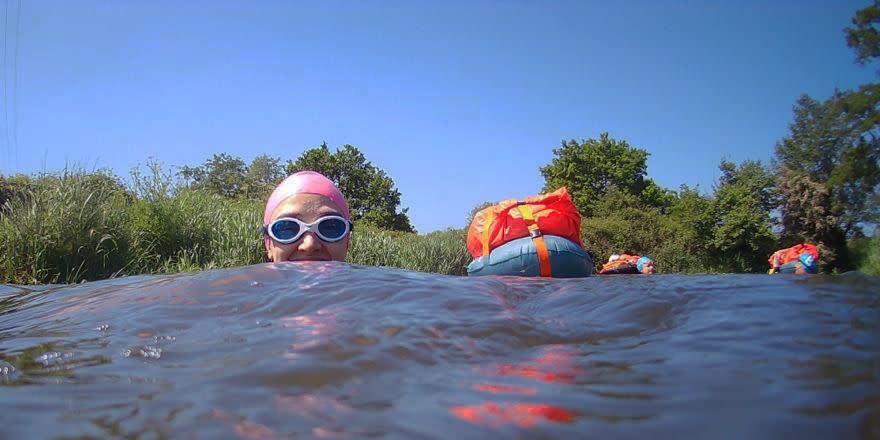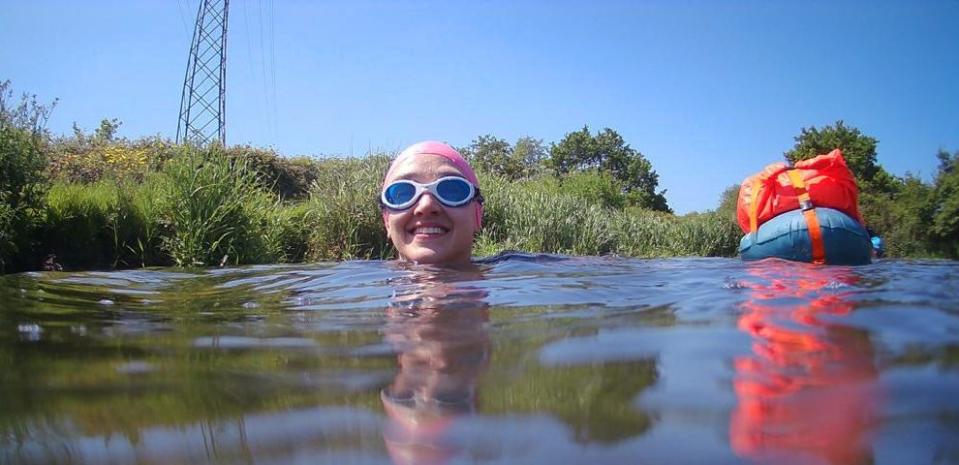'Cross-country swimming is on the rise. I tried it and have all the deets'

To be honest, when the idea of cross-country swimming was first proposed to me, I wasn't exactly sure what it would involve. As my brain tends to, it imagined the most dramatic of scenarios where, depending on the distance of the swim and the body of water I found myself in, survival wasn't a given.
One cross-country swim later, and I can say the reality is much more relaxing (although I'm sure you could create such a perilous journey should you wish).
While I didn't end up battling currents in the middle of nowhere in the ultimate test of resilience (relief), I was able to find a moment of peace in what would typically have been a jam-packed Friday. A moment I only had to take a 20-minute train ride and 10-minute car trip from London to get to. Here's everything I learned along the way.
What is cross-country swimming?
According to Tom Watt, co-founder of Above Below – a cross-country swimming-focused company organising events, providing equipment and sharing routes – '"Cross-country swimming" is a continuous journey over land and water (from A to B taking all your kit with you). It combines the joys of hiking with the invigorating thrills of wild swimming, bringing together the best of both worlds in one route to create a unique experience.'
Being a complete newbie, I thought it best to enlist a professional and turned to Paul Mackenzie from Adventure Swims, a cross-country swim guide leading trips across Surrey and Berkshire, who would not only bring experience and knowledge of the area we chose with him but, as it turned out, some tasty home-made treats too.
Fast forward a couple of days of planning to a Friday morning, with some not-so-average London weather (the sun had decided to show up), and I was making my way to Woking Station, armed with a backpack full of all the swimming gear I could find, and mixed emotions. Yes, I was excited, but I was also a little apprehensive about what I'd signed up for.
We'd decided on a portion of the 'Surrey Explorer' swim as it was easy to get to from where I lived, which meant that once I'd made it to Woking, all I had to do was take a quick car ride, courtesy of Paul, to the parking lot near Ripley that was to be the start of our grand adventure. There we met up with the rest of the group and readied ourselves for what was to come (aka discussed our game plan and plotted our path on a map before putting our backpacks on).
Then we were off, replacing the shaded car park with green meadows, blue skies and the river Wey. Walking along the meandering trail towards our swim starting spot, it was easy to see how Londoners who had followed a similar course before felt like they'd escaped to a different country. Bar a few power lines, there was nothing to hint at the fast-paced city life continuing as usual less than an hour away.
About 20 minutes of gentle hiking later, we arrived at the bank that was to be our entry point into the river and spread out amongst the tree cover to get our gear together. I'd done many a hike to an open water swimming site of my choosing over the years, but I'd never actually swum a part of the route before.
Instead, I'd always ended up entering and exiting the water at the same place and leaving my stuff sitting pretty on the side. But for cross-country swimming, this wouldn't do, so naturally, I would have to up my kit game to get from start to finish without water-logged belongings. That's where the RuckRaft from Above Below came in.
What is a RuckRaft?
As the name suggests, a RuckRaft transforms your rucksack into a raft by combining a 100L drybag with a U-shaped inflatable that you can tow behind you as you swim. The drybag is there to ensure that regardless of what you take along for the ride, be that a backpack, snacks (never forget the snacks) or your electronics, they will remain as dry as they were when they first entered the bag (as long as you seal it correctly), while the raft keeps it all afloat.
How to use a RuckRaft
Using a RuckRaft is pretty straightforward, Tom explains. 'Simply fill the drybag with as little or as much as you want. Then inflate the raft itself and strap the drybag to it. Finally, attach the leash (provided) to your waist or ankle, and you are all set.'
You'll want to check that there's no excess air in your drybag before sealing the open end, folding it down as many times as possible and clipping it shut. But after that's done and you've secured it to your raft and your raft to yourself, the water-based section of your expedition can begin.
And so, ours did. We spent the next 45 minutes winding our way down the river with our RuckRafts gliding seamlessly along behind us. Swimming freestyle on some of the straight stretches and lying on our backs with our RuckRafts as a sort of buoyancy-aide when we wanted to take it all in but mainly just doing an easy breezy breaststroke with our heads above the water – all the while feeling as if we were in no rush with nowhere better to be.
What followed was a short pitstop on the bank of the river to warm up, appreciate Paul's baking skills and help a farmer locate her missing cows (we were no help whatsoever), and then we were back in the water once more, making our way to the exit spot and the final part of our hike that would take us (begrudgingly in my case) back to reality.
How to plan a cross-country swim
If casting aside your everyday worries and embarking on a land-and-water-based adventure sounds appealing to you, you'll want to put a plan in place first. Proper preparation will ensure you make the most of your time outdoors and help keep you safe.
Begin by deciding what area you want to explore and the way you want to go about it. 'Cross-country swimming is possible wherever there is land and water, and you can make it as challenging or as gentle as you like,' says Tom. 'Start small, building up as you feel more comfortable with your ability and kit.'
If you're swimming in the sea, you'll want to factor in the tide and currents, and if a river is your water of choice, understanding the flow will be key. For any body of water, you'll need to work out the best place to get in and out and map out a few emergency exits should you need to get out sooner.
When it comes to the hike, Tom recommends checking whether the land you intend on crossing or entering and exiting the water from is open to the public and getting permission beforehand if not.
There's also the option to pick a path already mapped out by someone else. Above Below, for example, offer several different hand-picked routes around the UK that have been created by local guides and outline the trip as well as its difficulty level, highlights and safety information to know before you go.
Alternatively, you can go through a company or guide specialising in cross-country swimming. That way, you can effectively just show up on the day and get going. You'll have someone experienced with you at all times who knows the region and can help out should anything go wrong, and if you're not sure whether you want to invest just yet, in some cases, you'll also be able to hire out the necessary equipment through the chosen company.
What to wear when cross-country swimming
What you'll need will vary depending on the course you'll be following, the time of year and the weather. But as Paul mentions, 'the key elements are to be safe, seen and warm both on and off the water.'
'You'll need to adapt your clothing for the conditions,' he explains. 'Depending on the walking or running terrain, you need to ensure you have comfortable clothing and footwear for the weather. That might be warm and waterproof clothing and walking boots for some routes, or sun hats, sun cream and sturdy trainers for others.'
'In terms of the swim sections, staying seen by other water users is critical, as is staying warm,' he adds. 'A wetsuit provides insulation as well as helping avoid potential brushes and scrapes with the river, seabed, or general weeds and branches you might encounter.'
A bright swimming cap or float (hello, fluoro orange RuckRaft drybag) is a good way to stand out and having queried the need for one and then felt the cold halfway through our swim, I can highly recommend a wetsuit even when the weather is warm and sunny.
You'll also want to bring swimwear for underneath your wetsuit and goggles if you intend on swimming with your face in the water. Plus, a changing robe that offers you warmth and shelter from the elements can be a real game-changer.
Is cross-country swimming safe?
'Any adventure that incorporates rough terrain and bodies of water has inherent risks, so it's important to have the right kit (and that it's all in good working order) and to plan your route as best you can in advance', advises Tom.
Having a fully charged means of communication – such as a phone – is a must, and as with many outdoor activities, Tom explains that taking a buddy along for the ride is always a good idea. 'Cross-country swimming is not only safer with a mate, but it's also so much more fun! If you wish to go alone, leave your plan with someone and make sure they know your rough timing and exact directions. Check in regularly and let them know when you're done.'
He also recommends spending some time figuring out what provisions you'll need. 'Be sure to take enough food and drink for your trip. Dehydration when swimming can sneak up on you as you don't realise you are sweating. Take plenty of water and high-energy food.'
Swimming in cold water (as is most of the water in the UK year-round) always carries risks, so appropriate gear for in the water and clothing to warm up once out of the water is vital. Never jump in headfirst. Instead, get in slowly and carefully, allowing your body to acclimatise.
Check the weather beforehand to ensure the conditions are safe and you have packed and dressed appropriately. And if you ever feel uncertain about the course you're swimming or hiking, take a path you feel more comfortable with or cut your outing short.

My final thoughts on cross-country swimming
I love being in and around water, so it was no surprise that I felt just as strongly about cross-country swimming. What I didn't foresee was how recharged I would feel after only half a day and in such close proximity to London.
The benefits of immersing oneself in nature and partaking in regular exercise aren't new to me. Even so, I still find it challenging to set aside time for the two and to switch off properly when I do. But having a preplanned activity that incorporated both in a new environment where the usual distractions (my emails and phone) weren't readily available really helped me to disconnect from the stresses of everyday life.
It was also a great reminder that looking after my mental and physical health, connecting with new people and appreciating the world around me is just as, if not more important, than all the rest.
Basically, after getting a taste of cross-country swimming, all I'm left wondering is, 'Where to next?'
You Might Also Like


